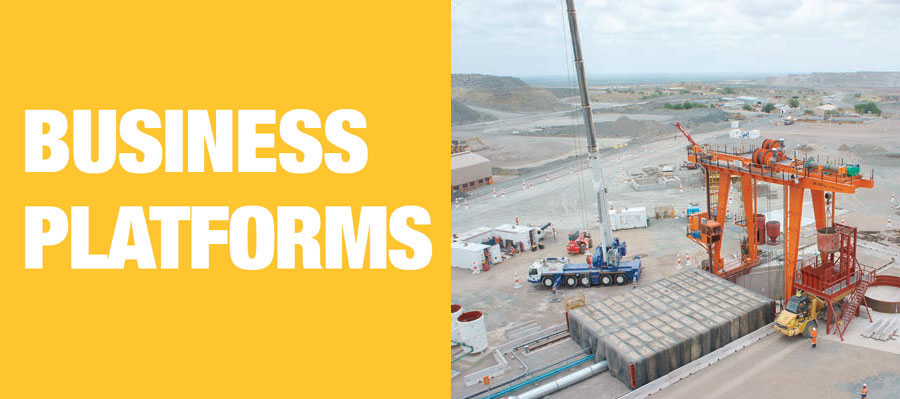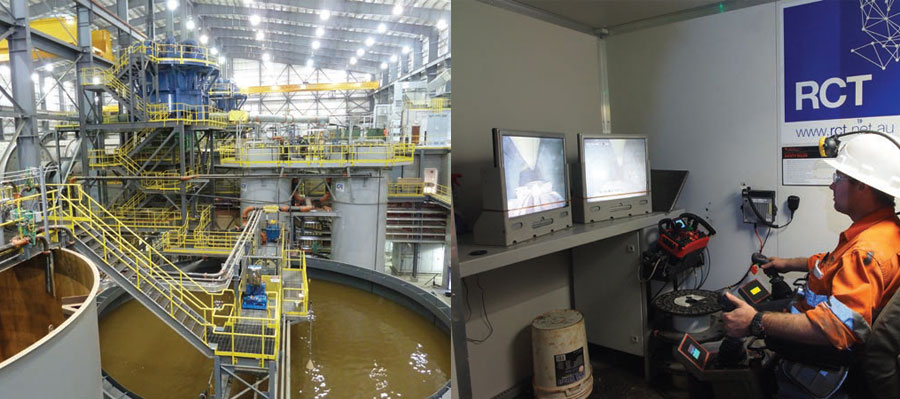BUSINESS PLATFORMS - UNDERGROUND MINING

MURRAY & ROBERTS CEMENTATION SUCCESSFULLY IMPLEMENTS ITS PRE-SINK GANTRY AT VENETIA
Murray & Roberts Cementation continues to develop innovative technologies aimed at enhancing safety and increasing efficiencies and productivity on their sites. By taking best practice components of methodologies used in other industry sectors such as civil engineering and tunnelling and then adapting them, Murray & Roberts Cementation produces new best practice technology for the mining sector. Following extensive development, Murray & Roberts Cementation implemented its innovative pre-sink gantry at its Venetia Project. This 21st century shaft sinking methodology is engineered to deliver optimal safe working conditions and comprises a single rail mounted gantry which combines the stage and kibble hoists as well as the blast barricade. The stage is suspended from the gantry on steel wire ropes attached to two 8 tonne stage winders on
purpose-built platforms to the sides of the main girders. “Enhanced safety and productivity is achieved with man and material loading being handled on one side of the gantry and waste rock being dumped from the other, which is achieved with the gantry traversing between these two points,” says Allan Widlake, Business Development Director at Murray & Roberts Cementation. The main hoist of the gantry, used for kibble hoisting and slinging, was custom engineered to allow a pre-sink of up to 80 metres below the collar elevation. On the Venetia Project an actual depth of 60 metres below collar elevation was sunk.
The hoist is able to raise and lower a kibble with a 10 tonne payload at a conveyance speed of 0.5 metres per second. The gantry system incorporates an automatic tipping frame. The kibble is slewed into its docking position where it is automatically positioned and hooked onto the frame. By lowering the hoist, the kibble’s payload is discharged into a truck waiting below.
Continues Widlake, “This system significantly reduces risk thereby enhancing safe working conditions and as it reduces tipping cycle times, there is also an increase in productivity.”
The height of the gantry structure is matched to the height of the stage and this allows the stage to clear the collar once raised to its upper limit. Once the stage has been raised in this upper position, the long travel wheel drive motors are energised to move the gantry, complete with suspended stage, away from the shaft. The blast
barricade is then drawn over the excavation and this effectively prevents fly rock from leaving the shaft barrel during blasting.
After blasting and clearing the shaft of the blast fumes by means of forced ventilation, the gantry rolls back to its position over the shaft, and the fully equipped stage is automatically aligned and positioned using a fully integrated programmable logic controller, and then lowered back into the shaft to the required depth.
An innovation which further facilitates productivity applies to projects where more than one shaft needs to be sunk. The pre-sink gantry offers the ability to pull itself along the rails between the first and second shaft positions.
“Being able to move rapidly from the one shaft to the second during the pre-sink phase offers major time saving advantages and further reduces risk,” says Widlake. Traditionally, set up for a pre-sink can take between one to three months but with this innovative technology it is now possible to achieve this over as little as two to
three days.
Further improvements on the pre-sink stage include integral mechanised drilling systems. This consists of six vertical drill rigs supported on swivel arms suspended under the stage. Each operator guides the drill and manoeuvres it to match the pattern of holes required for the blast. An inline pneumatic air leg on the rock drill extends to create the necessary thrust between the stage and the floor and for drill retraction after drilling is completed.
“This technology has reduced the physical effort involved in the drilling operation and most importantly there are no longer any manual drill operators in the shaft bottom,” continues Widlake. The shaft lining process has also been simplified. A proprietary shuttering system is now suspended from the sinking stage. The shutter depth is 6 metres and after each 6 metre excavation the shutter is positioned 12 to 18 metres above the shaft bottom. This means that the shutter can be left in position during drilling and blasting operations.
“The pre-sink gantry was not engineered for a single project and it is able to handle shaft pre-sinks from 6 metre diameters up to a large 10 metre diameter shaft,” Widlake concludes. This technology is set to change how shaft sinking is done on the African continent and is evidence of the Group delivering sustainable project engineering solutions.
CEMENTATION AMERICAS EXPANDS SERVICES ACROSS THE PROJECT LIFE CYCLE
In line with the strategic direction of Murray & Roberts to provide services across the project life cycle, Cementation operations in the Americas has expanded its service offering. Traditionally Cementation in Canada and the United States, has differentiated itself from the competition through a design-build style of contracting with a foundation built on a core of engineering excellence. The group has always been involved in early project study work, detailed engineering and underground excavation and construction. Two recent additions to the group have expanded these capabilities.
In late 2015 Merit Consultants International joined the Cementation group. Merit is a well-respected consulting company with over 30 years of experience in surface mine infrastructure construction management. This was a strategic acquisition for Cementation. Merit’s long term and well-structured construction management practices will support Cementation as the group takes on more engineer, procure and construct style work. Also, being able to offer surface construction management services, provides a wider bank of capabilities and even more assurance of a coordinated capital project. Merit’s involvement from studies through to construction is aligned with the Cementation approach and with Cementation’s support, Merit is in a strong position to also do construction management for underground projects. Merit’s long term
experience internationally, having worked in over 30 countries, is also beneficial to the group as Cementation’s geographical market expands.
Last year the Group also added Cementation Above Ground to its service offering. The Company, based in Salt Lake City, USA, is a specialist design-build EPC style contractor working in the minerals handling space, providing surface material handling and processing services on a “pit to port” scope. Anchored by a core of specialist engineering personnel and a strong management team, they are supported by Cementation’s engineering services. They also interact with other businesses within the
Murray & Roberts Group, including Clough’s North American operations CH·IV and Enercore.
With all of these elements in place, Cementation is in an excellent position to provide clients with services across the project life cycle, for both the underground and surface plant scopes. This seamless, one contractor approach, with early involvement, is the fastest route to production and a recipe for success on any major capital project.
RUC CEMENTATION MINING INNOVATES AT KARARI GOLD MINE
During the last five months, RUC Cementation Mining has implemented Minetec’s underground positioning and tracking tool at Karari Underground Gold Mine. This is an underground real-time positioning system which provides accurate tracking of assets by sending data across the underground ELF (Ethernet over leaky feeder) network, from each individual vehicle.
Each vehicle has had a touch screen monitor installed within the cabin. This enables the operator of each vehicle, to identify where every other vehicle is in the mine in real time. Each operator will be able to make an informed decision to determine whether they should proceed or alter their journey, which will enable greater productivity and efficiency within the operation. The real-time tracking will assist in eliminating light vehicle and heavy vehicle interactions.
RUC Cementation Mining has also worked with Minetec to develop Minetec’s SMART task automation system. This is a system where tasks are allocated to operators over the ELF system through to their touch screen. The SMART systems allows each operator to see the tasks allocated to every other operator, and to see what stage in the job cycle that other operator is at.
The combination of real-time tracking and SMART is a first for RUC Cementation Mining and Minetec in an underground developing operation.
Guidance
RUC Cementation Mining has introduced automated guidance technology to its primary bogger used in the extraction of gold ore from stoping blocks at the Karari Underground Gold Mine. The state-of-the-art technology autonomously drives the bogger, assisting it to avoid walls and major obstacles, increasing tramming
speeds, prolonging machine component life while keeping the machine in the optimal tramming path.
The automated guidance system allows the operator to set a predetermined path that the machine will travel on without the need for the operator to control steering; allowing the bogger do all the work. When the path is difficult to navigate or extends over a long distance the independent guidance feature will ensure reliable repeatable tramming.
This technology has allowed RUC Cementation Mining to use larger boggers (Sandvik 621) in tunnel profiles typically designed for smaller equipment (Sandvik 517), resulting in increased productivity and eliminating damage caused by accidental contact between side walls and equipment.
Early indications suggest a 40% increase in productivity, increased equipment availability and operator satisfaction.
Resin Cable Bolt
On another innovative front, RUC Cementation Mining has had successful trials replacing the industry standard application of cementitious grout with a resin grout for the installation of cable bolts. The main driver of this trial was to reduce the down time associated with curing times of cable bolts in headings as part of the jumbo development cycle. In partnership with Normet, early trials have shown curing times of installed cable bolts have reduced from 12 hours to 30 minutes from using a Normet’s Tampur 116T resin grout instead of the industry standard cementitious grout.
Due to the limited number of headings available for jumbo development, reducing the time taken for cable bolt grout to cure will significantly increase productivity and efficiency on site.


